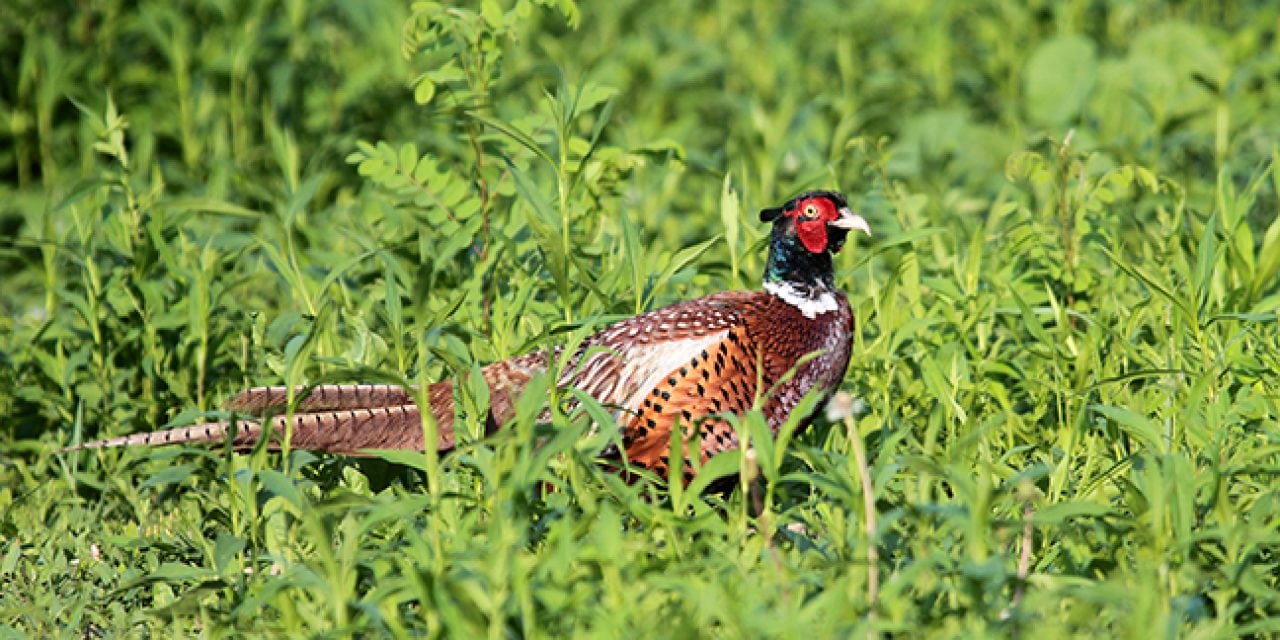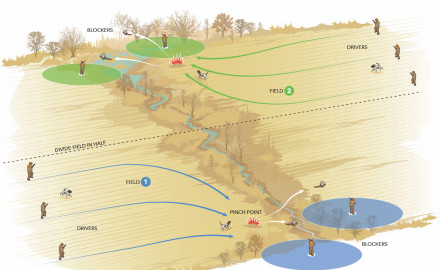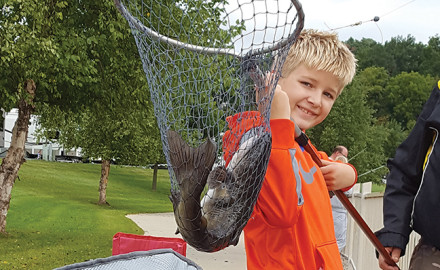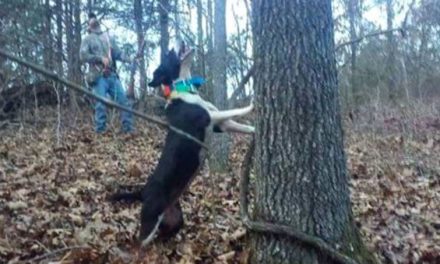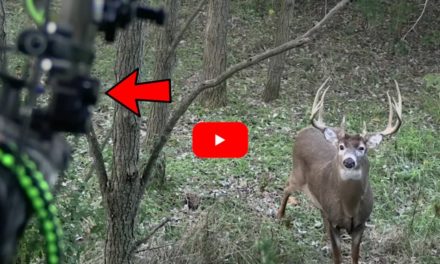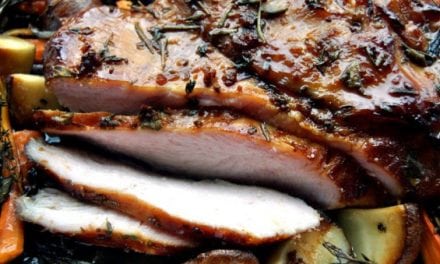Here’s what Iowa pheasant hunters can expect this season and where to find that opening day rooster.
The crack of the 16-gauge autoloader was sharp in the bitterly cold December air. Down but not out, the rooster pheasant crash-landed in the calf-deep snow, but was instantly on his feet and moving like only a ringneck can.
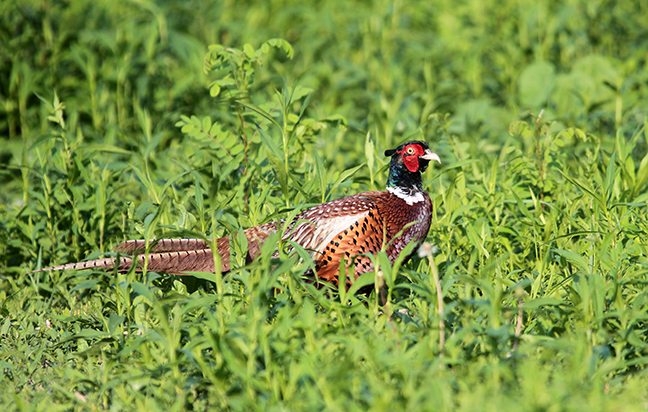
Photo Courtesy of Shutterstock
“Damn,” I said quietly, as I watched the bird hustle into the reed canary grass along the edge of the creek. Sadie Mae, my then two-year-old black lab, was in hot pursuit; unfortunately, and as a dedicated retriever of waterfowl, this was her first experience with a pheasant, alive or dead. “I’m not sure how this is going to work out,” I said, again to nobody in particular.
I needn’t have worried. Before I could slip another shotshell into the 1100’s tube, the hound had emerged from the grass, a lively though thoroughly subdued rooster pheasant clutched in her mouth.
“That one deserves a biscuit,” I told the pup, taking the rooster while digging a Milk-Bone out of a side pouch. Fifteen minutes later, a second bird, one of two dozen, perhaps more, that flushed en masse from a brushy tangle of sumac and multiflora rose, crumpled decisively at the autoloader’s report.
Sadie Mae, now a professional pheasant dog, made short work of the textbook retrieve.
For most, two rooster pheasants do not a season make; however, these birds were, for me, quite significant. The year was 2014, six years after I had begun my voluntary sabbatical from pheasant hunting in Iowa, a decision due simply to an alarming lack of birds, an absence particularly evident in my eastern third of the state. Iowa, the land of plenty for the pheasant hunter.
Iowa, where in what’s now known as the Glory Days during the early 1970s, more than two million roosters were harvested annually. Iowa, where a three-bird limit was, for many, the rule rather than the exception. Two birds. That year, two birds did make a season.
The reasons for the decline were there for everyone, biologist, hunter, and casual observer alike, to plainly see. Declining habitat was one; a huge factor stimulated by politics and the then-rising price of corn.
Five consecutive winters with above-average snowfall following by extraordinarily wet nesting seasons in those so-vital building months of April and May contributed a one-two punch. By 2011, Iowa pheasant hunters tallied a dismal 109,000 roosters, the lowest since the state game agency began keeping records in 1962. Was this the end of an outstanding upland era?
Fortunately, no. Come 2014, the year I killed my return-to-the-field roosters, Iowa hunters harvested an estimated 214,000 pheasants. In 2015, that number had risen to 270,000.
Roadside pheasant surveys conducted each August by the Iowa Department of Natural Resources also indicated an upswing, with statewide figures increasing from a 2011 low of 6.8 birds per 30-mile route to a Missouri-to-Mississippi average of 23.7 birds in 2015. And with the August 2016 surveys came news of 33- and 30-bird routes in northwestern and central Iowa, respectively. Pheasant hunters — an estimated 50,000 in 2014, and 56,000 in 2015 — have begun to return to the field.
Old side-by-sides are being brought out of hiding, brush pants are being dusted off, and canine assistants are being given refresher courses. Are the Glory Days here once more for Iowa pheasant hunters? No one, neither biologist nor hunter, will go so far as to say that; however, The Hawkeye State’s pheasant outlook is much more rosy today than it was a decade ago.
THE HUNTING OUTLOOK
It’s tough to peer into that all-knowing crystal ball and forecast a fall pheasant index anywhere birds exist, without first taking a backward glance at the previous winter — or winters — and how that weather might have impacted an area’s pheasant population.
“December (of 2016) was about average across the state of Iowa, but January, February and March tended to be a bit on the milder side,” said Todd Bogenschutz. Having served with the IDNR since 1995, Bogenschutz currently sits as the state’s upland game research biologist, along with the department’s Ag-Policy and Farm Bill Coordinator. “We had normal snowfall, or what the National Oceanic and Atmospheric Administration calculates as being normal.
“About 25 inches of snow; a little more up north, and a little less down toward Missouri. It seemed to be highly variable,” he continued. “We did have some thawing and refreezing, and that makes it tough for the birds to get (through) to the ground, but it thawed rather quickly. Overall, we didn’t see anything catastrophic.”
Nothing catastrophic, which is excellent when it comes to enlisting Mother Nature’s help in preserving an already delicately balanced wild population like Iowa pheasants. “For pheasants and quail in southern Iowa,” Bogenschutz said, “winter survival should have been above average.
“For the northern third of the state, I’d expect about average or perhaps (just) a little bit below normal over-winter survival. Now, and coming in to nesting season (April-May-June), we seem to be poised well. The 2016-17 small game harvest cards just went out, so we don’t know what the pheasant harvest was in 2016; however, and anecdotally, I’ve heard folks did quite well on pheasants and quail last year. The roadside counts were stable, and that bodes well for the coming year.”
In real estate, it’s location, location, and location. With pheasants, it’s habitat. And habitat. And habitat. Typically, and given suitable weather during the winter and that oh-so-important spring nesting period, pheasants that are afforded habitat will tend to themselves numerically. When, however, that habitat is taken away, be it developed or plowed under, bird populations respond negatively. It’s an elemental equation, and one that’s quite sobering, too.
“To answer the question about Iowa’s habitat fairly,” said Bogenschutz, “you have to know what you’re comparing. Is it 1960 when we shot two million roosters, or five years ago when we shot 100,000? Overall, we’re still losing habitat. The Conservation Reserve Program (CRP) got crunched in the last Farm Bill, going from 36 million acres (2007) to 24 million (2016) acres. And that was challenging for us. In 2000, we had 3.5 million acres of potential habitat (in Iowa),” he continued.
“By 2015, that was 2.7 million acres. This habitat trend isn’t what I’d like to be seeing; however, I think our CRP acreage actually bounced up a bit. The states to the west of us — Colorado, North Dakota, Montana — are seeing quite a loss in CRP acres. But there’s a new Farm Bill coming,” he said, “and there are landowners definitely interested into getting back into (the program).”
For Iowa pheasant hunters, habitat — in addition to the aforementioned CRP acres — comes in the form of privately owned ground under contract with the IDNR. Under the Iowa Habitat and Access Program, or IHAP, private landowners receive funding and hands-on technical expertise, both from the IDNR, in exchange for opening their land to public hunting.
“Currently,” said Bogenschutz, “we have in the ballpark of 24,000 acres enrolled in the program. Most of these contracts are for 10 years, so we’ll have access for quite a while, which is good. Could we enroll more if we had more money? Absolutely. We do have two grants for a combined four million dollars (on the table). And there is talk of raising license fees, and that would help us put a few more acres into the program. What we’re really waiting for,” he continued, “is the new Farm Bill, and there is talk of increasing the amount of money put into the Volunteer Public Access Program within the Farm Bill. If that’s the case,” he said, “we’ll submit another $3 million grant and try to expand that program.”
BEST BETS FOR BIRDS
Assuming a warm, dry nesting season was had throughout April, May and June, there’s really no reason why the majority of The Hawkeye State shouldn’t maintain the status quo — or better yet, record an increase — when it comes time for both the annual August roadside survey and the traditional end-of-October pheasant opener. That said, some areas of the state, perhaps not surprisingly, may prove more productive from a harvest standpoint than will others. Habitat, remember? And weather.
“The northwest corner of the state,” said Bogenschutz, “is some of our better pheasant range climatically. We saw 30 birds per route (in the northwest) in 2016. Thirty birds per route in central Iowa. And 25 birds per route in the southeast corner. There’s a band, it seems, from northwest to southeast.”
Elsewhere in the state, roadside counts ranged from the southwest and south-central regions posting 7.9 and 8.1 birds per route, respectively, to the east-central area along the Mississippi River with 15.4 birds. Overall, the surveys indicated a 20.7 bird per route average; slightly down from the previous year, but nothing, and to use Bogenschutz’s term, catastrophic.
The ringneck may hold center stage in Iowa; however, the Comeback Kid at present is without question the bobwhite quail.
“Quail numbers this past year,” said Bogenschutz,” were at a 27-year high. Based on the roadside survey, they’re the highest numbers since 1989.
“I had been thinking we had filled all our suitable (quail) habitat; however, based on the quail I heard calling while doing prairie chicken counts in southern Iowa, I might have to eat those words. I heard positive reports from quail hunters throughout the 2016 season,” he continued. “And a gentleman who rode RAGBRAI (Register’s Annual Great Bicycle Ride Across Iowa) in 2016 told me he had heard quail in every county he was in. That’s impressive.” Those counties included Mills, Page, Union, Decatur, Appanoose, Wapello, Washington, and Muscatine, all located in the southern third of the state.
Less stellar, unfortunately, is the state’s population of Hungarian (grey) partridge. “Huns,” said Bogenschutz, “really do well in sustained drought years. And we haven’t had much of that kind of situation in recent years. Populations peaked in the late 1980s,” he continued, “and have fallen since then. Today, we’re hoping to maintain the status quo (in regard to Hungarian partridge). Statewide, we’re at roughly three birds per survey route, and those relegated to northwest and north-central Iowa. Essentially, we have no partridge south of Interstate 80, but rather north of Highway 20.”
As to where to go come opening day, the opportunities are quite varied and stretch from river to river. Although Iowa currently ranks 49th in terms of the amount of public hunting land she offers, there are plenty of smaller, i.e. 50 to 150 acres, public parcels scattered across the landscape, which includes Bogenschutz’s aforementioned 24,000 acres enrolled in IHAP. A list of these holdings, along with interactive maps of the state’s more than 375,000 acres of wildlife management areas, can be found on the agency’s website.
In northern Hancock and southern Winnebago counties, several IDNR parcels, each within a short drive of one another, are located to the north and west of Clear Lake. Similar state-sponsored opportunities exist north of the town of Thompson in Winnebago County.
Farther to the west, Emmet County’s Swan Lake and High Lake areas hold promise; so, too, do state-owned properties scattered along the Clay/Palo Alto County line near Lost Lake. As in years past, Johnson County’s Hawkeye WMA adjacent to the Iowa River south of Cedar Rapids should be productive, as should the Iowa River Corridor WMA, which follows the Iowa from near the town of Tama upstream to Marengo down, and encompasses some 9,600 acres.
No matter where a hunter lands in Iowa’s pheasant country, 2017 is bound to be a better season than has been experienced in previous years. Where the population is going is anyone’s guess, but all fingers are crossed for the best.
“If we have a good nesting season,” said Bogenschutz, “you’ll see pheasant and quail numbers go up. If it turns wet on us, you’ll see those numbers go down or we’ll maintain the status quo. It all depends on what happens during April and May. Spring did come a bit early (this year), and we tend to see a positive response from the birds when we have an early spring. We’ll see if Mother Nature cooperates.”
Pheasants: Rethink Your Bird Hunting
But somewhere in that simple process, the human element can interfere. Preconceptions multiplied by misconceptions can soon equal poor implementation….
2017 Iowa Top Bass Fishing Spots
If you like to catch bass — largemouth or smallmouth — you’re going to like Iowa’s bass ….
2017 Iowa Fishing Forecast
Looking ahead to the coming year’s fishing opportunities, the things that make Iowa….
The post Iowa Pheasant Hunting Outlook 2017 appeared first on Game & Fish.

